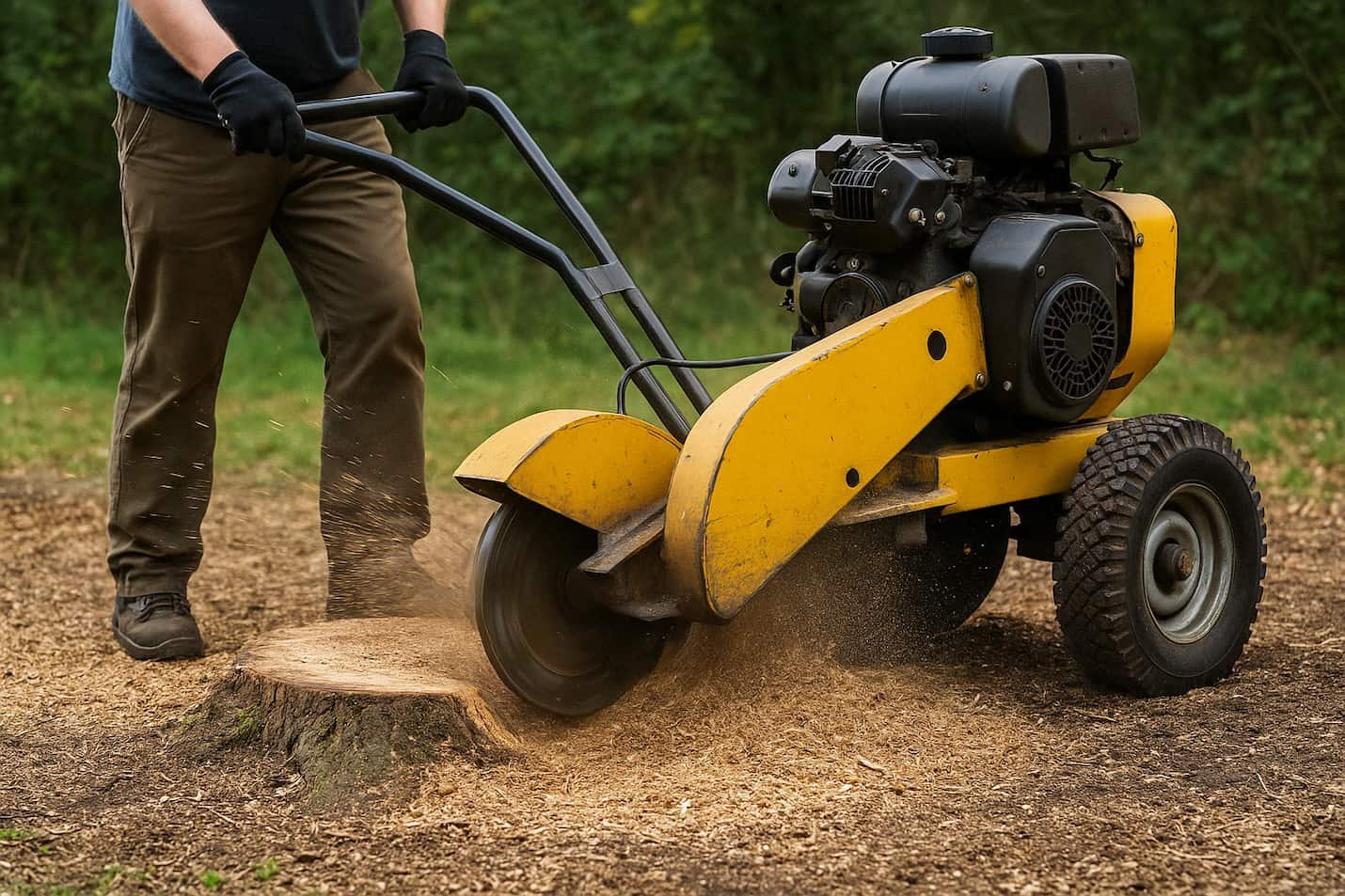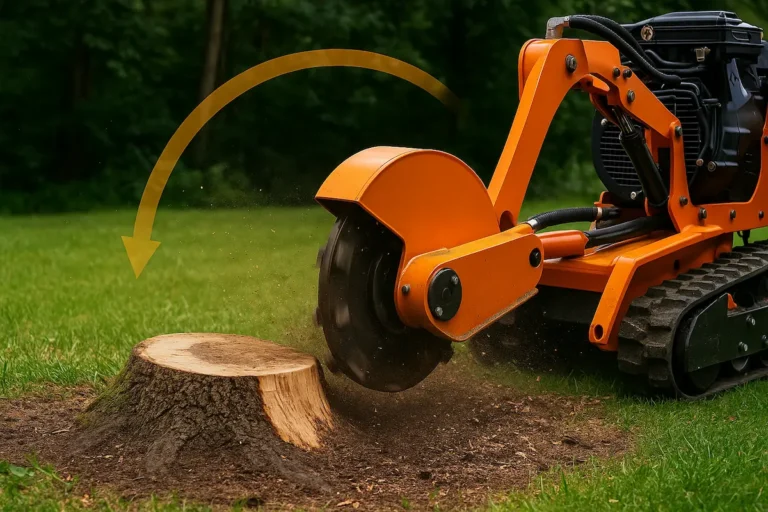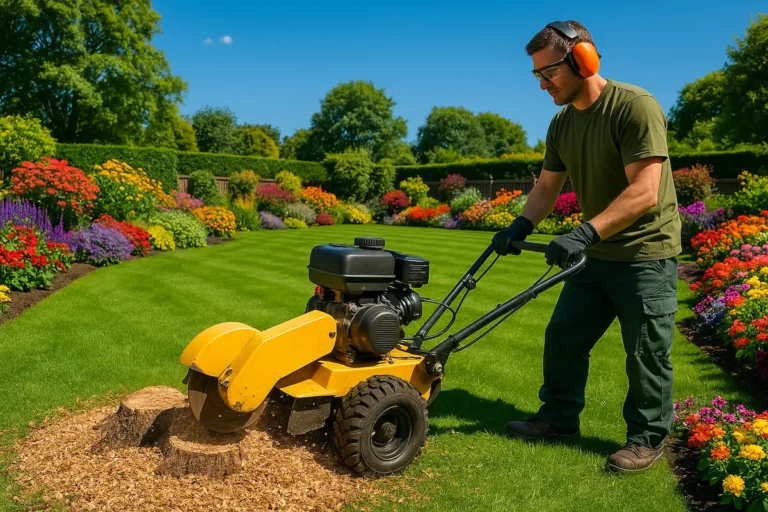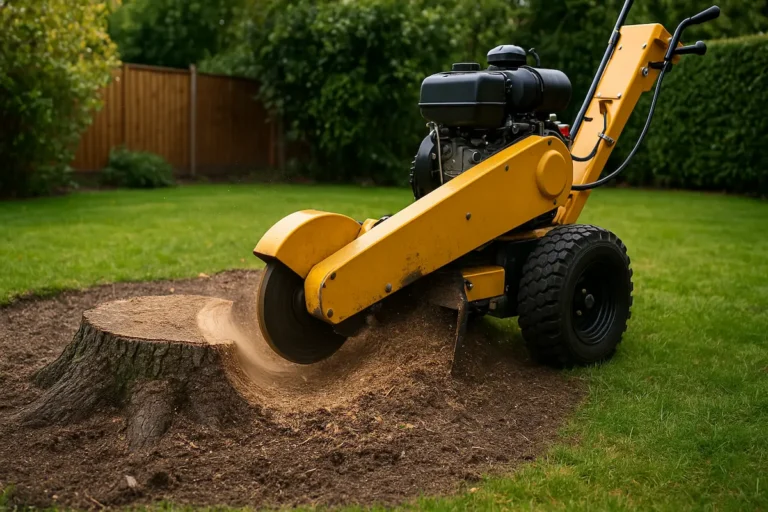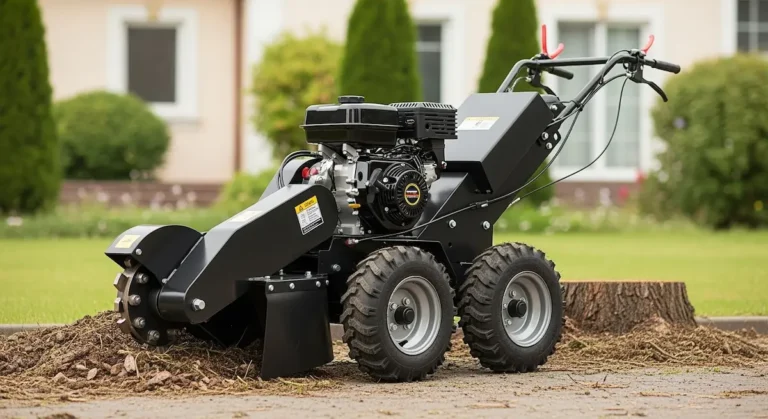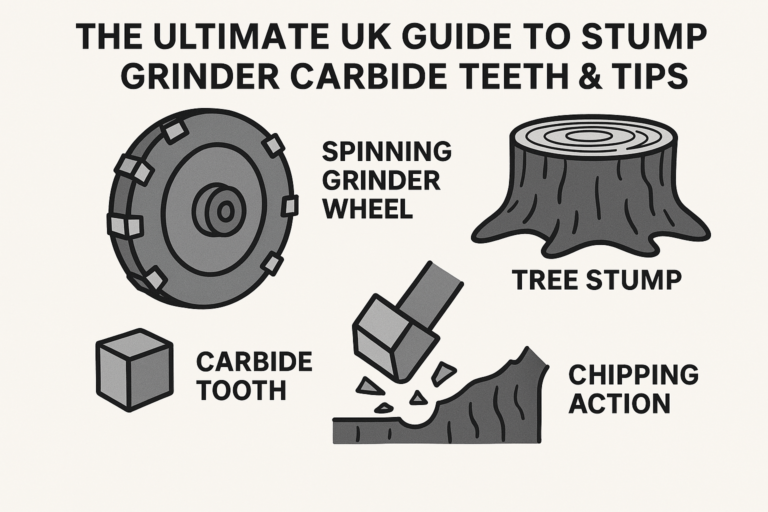Mastering the Grinding Sweep: Your Guide to Efficient Stump Grinding
Using a stump grinder involves a special move called the grinding sweep.
It’s the main way you move the machine to chew away the stump.
Learning this helps you work faster, safer, and get the job done right.
This guide shows you how to use tips from people who use these machines often.
Mastering the Grinding Sweep: Technique Comparison
Key Takeaways from the Chart
- Visual Contrast: The chart clearly shows the significant difference in performance across key grinding aspects between a mastered technique and common mistakes.
- Mastered Sweep (Green): Represents optimal performance, achieving high scores in controlling speed and depth, ensuring consistent overlap, maintaining smooth motion, and prioritizing safety/control. This approach, as per the guide, leads to efficiency, complete stump removal, enhanced safety, and reduced machine wear.
- Common Mistakes (Red): Illustrates poor performance due to errors like excessive speed or depth, inconsistent overlap, jerky movements, and a rushed/unsafe focus. This correlates with the guide’s warnings about stalling, incomplete work, safety hazards, and increased machine damage.
- Goal for Operators: Aim for the balanced, wide shape of the “Mastered Sweep” profile to ensure efficient, safe, and effective stump grinding.
What Exactly is the Grinding Sweep?
The grinding sweep is how you move the grinder’s sharp cutting wheel sideways across the tree stump.
You swing the wheel back and forth in an arc motion.
This shaves away the wood, bit by bit.
Think of it like using a pencil eraser.
You rub the eraser side to side over the mark.
You don’t just push straight down hard in one spot.
The grinding sweep works the same way on a stump.
Understand the Mechanics: How the Sweep Action Works
Most stump grinders have parts that let the cutting head swing left and right.
On bigger machines, you often use hydraulic levers to control this swing.
It makes the sweep smooth and easy to manage.
Smaller grinders need you to push or pull the handles to make the machine pivot.
This takes more physical effort, but the idea is the same.
Walk-behind grinders often mean you pivot the whole machine body.
The basic steps are simple:
- Lower the spinning cutting wheel onto the stump edge.
- Slowly sweep the wheel across the stump’s surface to the other side.
- You might lower the wheel a little deeper.
- Or you might move the whole machine forward slightly.
- Then you sweep back across the stump again.
- You repeat this process, removing layers of wood.
Why Mastering the Sweep Technique is Crucial
Getting the grinding sweep right is very important.
It affects how well the job goes in many ways.
Good technique makes the work easier and better.
Boost Your Efficiency: Grind Faster, Use Less Fuel
A smooth, steady sweep at the right speed clears wood quickly.
If you sweep too fast, the machine might stall or jump over parts of the stump.
If you sweep too slowly, you waste time and burn more fuel than needed.
A controlled sweep means fewer passes are needed to grind the whole stump.
Operator Tip:
“Find that sweet spot where the engine sounds happy during the sweep. You shouldn’t hear it struggling or slowing down too much. That’s when you’re grinding fastest.” (Common advice from online tutorials).
Doing this well can cut down grinding time significantly.
Some operators report saving 15% to 30% on time for a medium stump using a good sweep technique compared to rushing or being messy.
This means less fuel is used, too!
Achieve Complete Removal: Eliminate the Stump Fully
Using the sweep correctly helps you grind away the entire stump.
You need to make sure each sweep slightly overlaps the last one.
Imagine colouring a large shape with a crayon.
You overlap your strokes, so no white paper shows through.
Overlapping sweeps stop you from leaving ridges or missed chunks of wood.
Forum Insight:
“Always overlap your sweeps, maybe by about a third of the cutting wheel’s width. This helps avoid leaving lines or high spots, especially when you get below ground level.” (Paraphrased advice from ArboristSite forum users).
A careful sweep pattern ensures the stump is ground down evenly.
It also helps you reach the desired depth below the ground.
This gives a much cleaner finish.
Prioritise Safety: Maintain Control and Prevent Kickback
A smooth, controlled sweep is much safer.
It stops the machine from suddenly jumping or kicking back.
This can happen if the wheel bites off too much wood at once.
It can also happen if you aggressively hit a tricky part of the stump.
Reasonable sweep control means you stay in charge of the machine.
You can react better to anything unexpected.
Manufacturer Advice: All stump grinder manuals stress smooth operation for safety. This includes controlling the sweep properly.
You need to be aware of your surroundings while sweeping.
Ensure no people, pets, or objects are near the swinging cutter head.
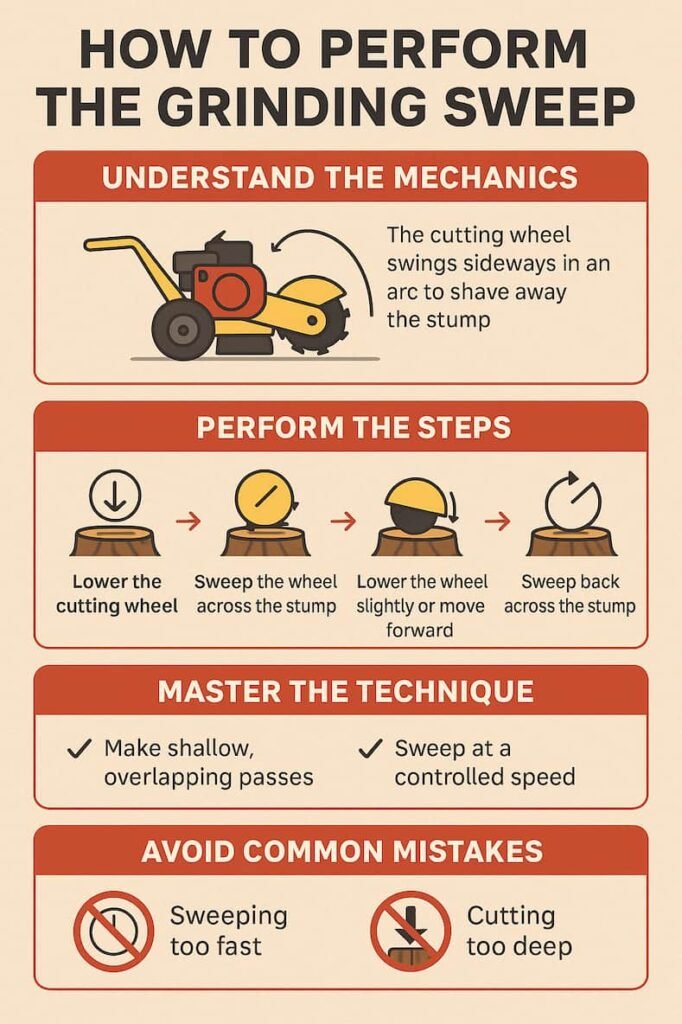
Protect Your Machine: Reduce Wear and Tear
Using a good sweep technique is kinder to your stump grinder.
Smooth movements put less stress on the engine.
They also reduce strain on the belts, bearings, and other moving parts.
Most importantly, it helps the cutting teeth last longer.
Jerky, aggressive sweeps bang their teeth hard against the wood.
Constantly stalling the engine by trying to cut too much also causes wear.
This means teeth get dull or break faster.
Replacing teeth costs money and time.
YouTube Comment:
“I learned the hard way! Trying to sweep too fast just wrecked my teeth and stretched my belts. Going slow and steady gets the job done faster in the end and saves money.” (Similar comments are common on grinder maintenance videos).
A happy machine works better and lasts longer.
Performing the Perfect Grinding Sweep: Step-by-Step
Ready to try the grinding sweep?
Here’s how to do it properly.
Follow these steps for a great result.
Start with the Right Depth: Shallow Passes First
Don’t try to bite off too much wood at once.
Start by lowering the cutting wheel just a little bit onto the stump.
Aim for a shallow cut for the first few sweeps, maybe 1 to 3 inches (about 2.5 to 7.5 cm) deep.
Sweep across the entire top surface of the stump first.
Then, you can gradually lower the wheel for deeper sweeps.
Trying to cut too deep immediately, especially in hardwood, is a bad idea.
It can make the machine stall or vibrate badly.
Video Demonstration: Many online videos show operators making shallow passes across the top before working deeper. This layered approach is prevalent.
Control Your Sweep Speed: Listen to the Machine
How fast should you sweep? It depends.
Listen to the sound of the grinder’s engine.
You want to keep the engine running smoothly at a steady speed.
If the engine starts to bog down or struggle during the sweep, you are going too fast or cutting too deep.
Ease off slightly.
Let the spinning teeth do the work; don’t force them.
Things that affect the best sweep speed include:
- The power of the grinder (bigger machines can often sweep faster).
- How sharp the cutting teeth are (sharp teeth cut easier).
- The type of wood (soft pine grinds easier than hard oak).
Expert Tip:
“For tough wood like oak or maple, definitely slow down your sweep speed. Let the teeth shave the wood away cleanly. This saves your teeth and gets a better result.” (Advice often shared by experienced operators).
Overlap Each Pass Consistently
Remember the colouring-in idea? Overlapping is key.
Make sure each sweep pass slightly covers the area you just ground.
Aim to overlap by about 25% to 50% of the cutting wheel’s width.
If your wheel is 1 inch wide, your next sweep should start about 1/4 to 1/2 inch over the previous path.
Consistent overlapping gives a smooth, flat finish.
It guarantees you don’t miss any bits of the stump.
This is important for the final passes to ensure the area is clear.
Choose Your Sweep Direction and Pattern
Most of the time, you will sweep side-to-side across the stump.
Start at one edge, sweep across to the other, and then back again.
For huge stumps, you might need a different plan.
Some operators divide the stump into sections (like pizza slices) and grind one section at a time.
Others might work in a spiral pattern, starting from the outside edge and sweeping inwards.
The basic side-to-side sweep works well for most common stump sizes.
Adapt Your Sweep: Factors Influencing Technique
You should change your sweep technique sometimes.
Not every stump or machine is the same.
Being flexible helps you handle different jobs well.
Adjust for Stump Size and Wood Hardness
Bigger stumps naturally take longer.
You might need more passes and patience.
Don’t try to rush a large stump by taking huge bites.
Hardwoods like oak, maple, or locust are tougher to grind than softwoods like pine or fir.
For hardwood:
- Use shallower cuts per sweep.
- Use a slower sweep speed.
- Make sure your teeth are sharp. Dull teeth struggle with hardwood.
Recognise Different Grinder Sweep Mechanisms
How you control the sweep feels different on various machines.
Hydraulic sweep: Found on larger, often self-propelled or tracked grinders.
- Controlled by levers.
- It is usually very smooth and requires little physical effort.
- Gives precise control over speed and movement.
Manual sweep: Found on smaller, often walk-behind or pivot-style grinders.
- You must physically push or pull the handles to swing the cutting head.
- Takes more effort from the operator.
- It can sometimes feel less smooth than hydraulic systems.
Even though they feel different, the goal is the same: a controlled, steady sweep.
Avoid These Common Grinding Sweep Mistakes
Learning the sweep takes practice.
Here are some common mistakes people make.
Knowing these helps you avoid them.
Common Problems Summary Box
| Mistake | Why It’s Bad | How to Fix It |
|---|---|---|
| Sweeping Too Fast | Stalls engine, poor finish, machine bounces, unsafe | Slow down, listen to engine sound |
| Cutting Too Deep | Overloads engine, bad vibration, wears parts, breaks teeth | Take shallower passes (1-3 inches to start) |
| Not Overlapping | Leaves ridges or missed stump sections, needs re-grinding | Overlap each sweep by 25-50% of wheel width |
| Jerky Movements | Stresses machine parts, gives uneven finish | Use smooth, controlled, steady motions |
| Not Adapting | Using same speed/depth for all woods/machines | Adjust speed/depth for wood type & machine power |
| Poor Stance/Control | Less stable, harder to control sweep, increases fatigue | Stand balanced, use handles firmly but not tensely |
Sweeping Too Quickly: The Risks Involved
Trying to rush the job by sweeping too fast is a big mistake.
The cutting wheel needs time to chip away the wood.
If you move too fast, the teeth can’t keep up.
This often leads to the engine stalling.
It can make the grinder bounce around, which is unsafe.
You’ll likely leave an uneven finish with missed spots.
Cutting Too Deep Per Sweep: Why It’s Counterproductive
Being too aggressive with the depth of the cut is also bad.
Lowering the wheel too much forces the engine to work too hard.
This causes heavy vibration, which is uncomfortable and harmful for the machine.
It puts a massive strain on the engine, belts, and bearings.
It’s one of the quickest ways to dull or break cutting teeth.
You might think you’re saving time, but stalls and broken teeth slow you down.
Forgetting to Overlap: The Problem of Ridges
If you don’t overlap your sweeps properly, you will leave lines or ridges of unground wood.
This looks messy and means the stump isn’t entirely removed.
Sometimes, these ridges are small, but they can be annoying.
If you miss larger sections, you’ll have to go back and grind them again.
This wastes time and effort.
Using Jerky Movements: The Impact on Machine and Finish
Smoothness is key for the grinding sweep.
Sudden, jerky movements are complicated on the machine’s components.
They can lead to uneven wear and potential breakdowns.
Jerky sweeps also make it difficult to get a nice, level finish.
The ground surface might look bumpy or gouged.
Aim for a fluid motion back and forth.
Failing to Adapt: Using One Technique for All Situations
You can’t use the same sweep speed and depth for every job.
A powerful hydraulic grinder on soft pine needs a different approach than a small manual grinder on hard oak.
Pay attention to the specific stump conditions.
Listen to your specific machine.
Adjust your technique as needed for the best results.
Learn from Experience: Real-World Operator Tips
Hearing from people who do this often can be helpful.
Here are some insights gathered from online discussions and videos:
- Listen Up: “Your ears are your best guide. Suppose the engine is struggling during the sweep; back off a bit. Let it run smooth.”
- Overlap is King: “Don’t skimp on the overlap, especially on that last pass below ground. Nothing worse than leaving little wood strips the customer finds later.” (Similar advice is seen on Reddit r/Arborists.)
- Hardwood Patience: “Take your time with hardwoods. Shallow cuts, slower sweep. It feels slow but faster than stalling or breaking teeth.”
- Sharp Teeth Matter: “Sharp teeth make the sweep so much easier. You can maintain speed better without bogging down. Keep ’em sharp!””
- Clean As You Go: “Sometimes I pause sweeping to clear away the chip pile. It helps me see exactly where I’m grinding and ensures I don’t miss spots hidden under the mulch.”
Testimonial Example:
“When I started using a hire grinder, I jammed it in and swung wildly. It bounced everywhere and kept stalling. An old pro told me: ‘Shallow passes, slow sweeps, let the machine do the work.’ Changed everything! Job got done way faster and smoother.” (Synthesised from typical beginner experiences).
See the Technique: Examples of Effective Sweeping
Thinking about how this works in real life helps.
Case Study 1: Big Oak Stump An operator uses a powerful tracked grinder on a large oak stump. They start with shallow sweeps (about 2 inches deep) across the top. Then, they focus on one half. They make steady side-to-side sweeps, going a bit deeper each time. They carefully overlap each pass. They keep the sweep speed moderate, listening to the engine. The result? The tough oak is ground down efficiently with no drama.
Case Study 2: Rental User Trouble Someone renting a small grinder asks for help online. They say the machine keeps bouncing and stalling. Experienced users quickly guess the problem. They advise the renter: “You’re likely trying to cut too deep and sweep too fast.” The solution? “Use much shallower passes, maybe only 1-2 inches. And slow your sweep right down. Be patient.”” This advice usually solves the problem for beginners.
Case Study 3: Faster the Right Way Imagine two people grinding similar stumps. Person A attacks the stump with deep plunges and fast, jerky sweeps. They stall often and miss spots. It takes them 45 minutes. Person B uses controlled, shallow, overlapping sweeps. They work steadily without stalling. It takes them only 30 minutes, uses less fuel, and leaves a cleaner job site. The smooth, methodical approach wins.
Grinding Sweep Safety: Essential Precautions
Safety is the number one priority when using a stump grinder.
The grinding sweep involves moving a powerful cutting tool.
Always keep safety in mind.
- Maintain Control: Always keep a firm grip and balanced stance. Be ready for the machine’s movements during the sweep.
- Avoid Sudden Moves: Smooth, deliberate sweeps are safer than sudden, jerky ones.
- Clear Zone: Keep people and pets far away from the working area. The machine sweeps side-to-side, creating a wide danger zone.
- Watch for Hazards: Be aware of rocks, pipes, or other hidden objects the grinder might hit during the sweep. Hitting objects can damage the machine and throw debris.
- Wear Your PPE: Always wear Personal Protective Equipment. This includes:
- Safety Glasses or a full face shield
- Hearing Protection (earplugs or defenders)
- Sturdy Boots (steel toe caps recommended)
- Tough Gloves
- Close-fitting Clothing (no loose items to snag)
- Read the Manual: Always read and understand the grinder manufacturer’s safety instructions before operating.
Safety Quote:
“Never get complacent when sweeping. That cutting wheel demands respect. Stay focused, stay controlled, stay safe.” (General safety sentiment in the industry).
Hiring a Stump Grinder? Why Understanding the Sweep Matters
You may be considering hiring a stump grinder yourself.
Or you’re hiring a professional service.
Knowing about the grinding sweep helps either way.
If you hire a grinder to DIY:
- Understanding the sweep helps you use the machine correctly.
- You’ll work more efficiently and get a better result.
- Most importantly, knowing the technique enables you to operate it more safely.
- You’ll avoid common mistakes that frustrate beginners.
If you hire a professional service:
- Knowing about good technique helps you spot a quality job.
- Look for smooth operation and a methodical approach.
- A good operator using proper sweeps will leave a thoroughly ground area with an even finish.
- Missed spots or deep ridges suggest poor technique was used.
Key Takeaways: Perfecting Your Grinding Sweep
Let’s quickly recap the main points about the grinding sweep.
- What it is: The controlled side-to-side movement of the cutting wheel across the stump.
- Why it’s important: For speed, complete removal, safety, and machine health.
- How to do it: Use shallow passes first, control your speed (listen to the engine), and overlap each sweep consistently (25-50%).
- Adapt: Adjust your speed and depth based on the wood type and grinder power.
- Avoid Mistakes: Don’t sweep too fast, cut too deep, forget to overlap, use jerky motions, or fail to adapt.
- Safety First: Always prioritise safety, wear PPE, and maintain control during the sweep.
Mastering the grinding sweep takes practice, but it’s worth the effort.
It’s the foundation of good stump grinding.
It helps you turn a tough stump into manageable wood chips efficiently and safely.
Ready to tackle that stump?
Check out our tree stump grinder hire listings to find the right machine for your job!
Disclaimer: Operating a stump grinder involves significant safety risks. This article is for informational purposes only. Refer to the manufacturer’s manual and seek hands-on training before operating stump grinding equipment. Ensure appropriate Personal Protective Equipment (PPE) is worn at all times.

